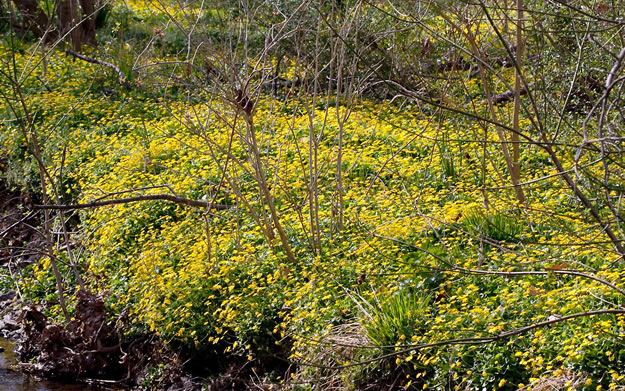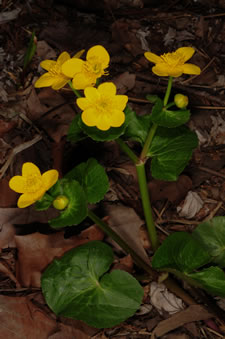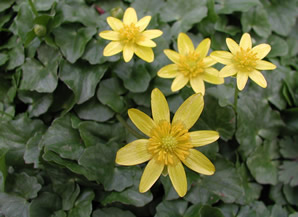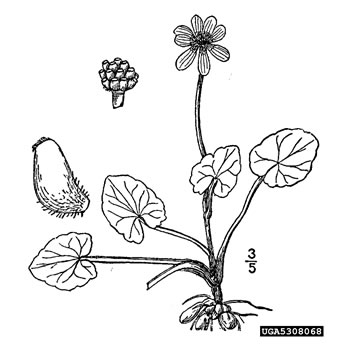Invasive Alert!
by Marianne Cote*
Reprinted from the Spring 2011 edition of New Leaf, the newsletter of the Botanical Gardens at Asheville, an organization “dedicated to preserving and promoting our native plants.” Used by permission.
To see pictures or additional information about a particular plant, click its name.

Infestation of Fig Buttercup along Upper Greenway, UNC Asheville. Photo by Jim Petranka.
A keen sense of disappointment was felt by everyone closely connected to the Gardens when what was first thought to be an early and particularly prolific appearance of Marsh-marigold (Caltha palustris) actually turned out to be an invasion of Lesser Celandine (Ficaria verna, formerly Ranunculus ficaria), also known as Fig Buttercup.
Marsh-marigold

Marsh-marigold (Caltha palustris) is a member of the buttercup family, and from late March to late May, adds its bright yellow blossoms surrounded by deep green leaves to the early spring landscape. In the BGA (Botanical Gardens at Asheville), it grows in small, isolated clumps in several moist locations. Its cheerful beauty makes it a desirable, although not readily available, garden plant that provides nectar and pollen for bees and beetles and seed for birds and small mammals.
Marsh-marigold is a noninvasive native to our region that in December, 2010, was added to the Protected Plant Species List (02 NCAC 48F .0301) by the North Carolina Department of Agriculture and Consumer Services. (1)
Photo by Tim Spira, Clemson University.
Lesser Celandine (Fig Buttercup)

Unfortunately, an insidiously invasive look-alike has recently made its way into North Carolina and is being sold by some commercial nurseries as a substitute for the harder to find and grow Marsh-marigold.
Ficaria verna (previously Ranunculus ficaria) is most commonly known as Lesser Celandine, but that name adds one more dimension to the confusion that this plant breeds. Ficaria verna, a member of the buttercup family, is neither a marigold nor a celandine. For the purpose of clarity, let’s call it by its more justifiable name of Fig Buttercup!
Photo by Leslie J. Mehrhoff, University of Connecticut, Bugwood.org
US Bureau of Land Management: Plant Conservation Alliance
The Plant Conservation Alliance’s Alien Plant Working Group has nothing good to say about Fig Buttercup in the U.S. (native range: Europe, northern Africa, western Asia, Caucasus and Siberia). It was originally introduced in this country as an ornamental and is currently reported as invasive in seventeen states in the northeast and one western state, Oregon. (2)
Very recently, it has begun to invade North Carolina. Just a couple of weeks ago, it was found in a swath along the Greenway at UNCA and had migrated downstream into the Botanical Gardens. A joint BGA and UNCA team has been formed and is now actively working on control measures. This was the first reported sighting for Western North Carolina.
Ecological Threat
Fig Buttercup is a vigorously growing herbaceous plant that completes its life cycle during winter and spring and competes with many native plant species for light, nutrients and space. Its emergence before most native species gives it a great competitive advantage.
Once established, it spreads rapidly, forming a solid green blanket across the ground through which native plants are unable to penetrate.
Among the spring ephemerals that are threatened by Fig Buttercup (in addition to Marsh-marigold) are Virginia Bluebells, Toothworts, Dutchman’s Breeches, Trout Lily, Trilliums, Bloodroot and many, many others.

Another factor, besides its prolific growth, that makes Fig Buttercup such a menace is its tenacity for reproduction that resists nearly all attempts at managing its growth. The plant makes numerous tubers and bulblets, each of which can grow into a new plant once it’s separated from the parent plant. These are spread by animals, well-meaning human weed pullers and water events.
Because of its short life cycle, there is a limited window of opportunity for controlling it and control methods are limited. Currently, there are no biological control agents, and chemical pesticides present a danger to native wildflowers and amphibians, many of which are emerging at the same time. Hand pulling and digging with a small trowel in early spring are likely the safest methods, but these are labor intensive and work best on small infestations. All bulblets and tubers must be removed and plant materials bagged up and disposed of in a landfill or incinerator. (3)
Ficaria verna. Drawing provided by USDA PLANTS Database, USDA NRCS PLANTS Database, Bugwood.org
| Marsh Marigold | Fig Buttercup/Lesser Celandine | |
|---|---|---|
| Roots | Fleshy, tangled with no tubers | Have many tubers |
| Stems | No bulblets on stems | Bulblets forming at the nodes of stems |
| Flowers | Five to nine yellow petal-like sepals | Three green sepals and 7-12 yellow/white petals |
| Leaves | Glossy rounded or kidney-shaped | Dark green kidney to heart-shaped leaves |
| Habitat | Edges of ponds, wet woods, moist soils | Low open woods, floodplains, meadows and waste places |
| Growth Habit | Grows in clumps | Forms a continuous carpet |
Conclusion
Fig Buttercup, aka Lesser Celandine, is just beginning to gain a foothold in this region. It will require vigilance and hard work to prevent it from continuing to spread. For the good of our native ephemerals, don’t buy it from commercial nurseries or allow it to become established on your property!
Fig Buttercup/Lesser Celandine is now illegal in South Carolina
(as well as in Connecticut, Maryland, Massachusetts, and Ohio).
If you are in South Carolina and suspect that you have — or have found — Fig Buttercup,
please contact the Clemson University Department of Plant Industry at 864.646.2140 or
www.clemson.edu/regulatory/contact/
or contact your local Clemson University Extension Service office.
In addition, please email [email protected]
Sadly, Fig Buttercup is still available for purchase in many other states. Please share this article with gardeners (tell them not to buy!), nursery owners (ask them not to sell), and regulatory officials (ask them to consider adding this species to your state's list of regulated pest plant species).
For more information, watch the video at
www.scnps.org/citizen-science-invasive-fig-buttercup
and check out the information sources listed at the bottom of that page.
* Marianne Cote is President of the Botanical Gardens of Asheville.
The Gardens are located at 151 W.T. Weaver Blvd in Asheville, open to the public sunrise to sunset year round with no admission charge, and are dedicated to the study and promotion of the native plants and habitats of the Southern Appalachians. For more information about the Garden, visit www.ashevillebotanicalgardens.org
1) www.ncagr.gov/plantindustry/plant/plantconserve/plist.htm
2) www.nps.gov/plants/alien/fact/rafi1.htm
3) ibid.

